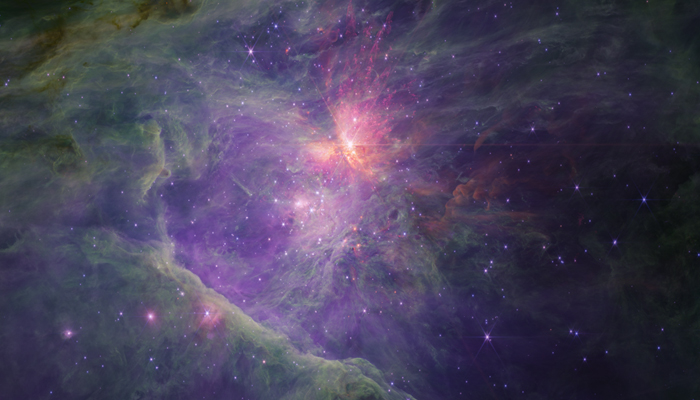James Webb Telescope reveals new insights on Orion Nebula
The experts also identified brown dwarfs — too small to start the nuclear fusion at their cores to become stars
October 09, 2023

New and remarkable images released by the miraculous James Webb Space Telescope revealed new details about the Orion Nebula — located at a distance of 1,300 light-years from Earth — the brightest one in the night sky which consists of clouds of dust and gas.
Astronomers have been studying the Orion Nebula due to the wealth of celestial objects it hosts including planet-forming disks around young stars and brown dwarfs.
The astronomers Samuel G. Pearson and Mark J. McCaughrean while studying focused on the Trapezium Cluster — a young star-forming region that’s about 1 million years old — filled to the brim with thousands of new stars.
The experts also identified brown dwarfs — too small to start the nuclear fusion at their cores to become stars.
The astronomers also found for the first time a planet-like object with masses between 0.6 and 13 times the mass of Jupiter that tries to challenge some astronomical theories.
The astronomers termed them as Jupiter Mass Binary Objects or JuMBOs.
Pearson, a European Space Agency (ESA) research fellow at the European Space Research and Technology Centre in the Netherlands: "Although some of them are more massive than the planet Jupiter, they will be roughly the same size and only slightly larger."
The astronomers found 40 pairs of JuMBOs and two triple systems, all on wide orbits around one another.
Although they exist in pairs, the objects are typically about 200 astronomical units apart, or 200 times the distance between Earth and the sun.
It can take between 20,000 and 80,000 years for the objects to complete an orbit around each other.
"The objects' temperatures range from 1,000 degrees Fahrenheit [537 degrees Celsius] to 2,300 F [1,260 C]," Pearson said adding that the gaseous objects are young, astronomically speaking — about 1 million years old.
"We are halfway through the life of the sun, so these objects in Orion are 3-day-old babies," said McCaughrean, senior adviser for science and exploration at the ESA.
"They’re still quite luminous and warm because the energy they have when they get created still allows them to glow, which is how we can see these things in the first place."
McCaughrean said: "This process continues as disks of gas and dust swirl around the stars, giving rise to planets. But no existing theories explain how the JuMBOs formed, or why they’re present in the Orion Nebula."
"Scientists have been working on theories and models of star and planet formation for decades, but none of them have ever predicted that we would find pairs of super low mass objects floating alone in space — and we’re seeing lots of them," Pearson said.
"The main thing that we learn from this is that there is something fundamentally wrong with either our understanding of planet formation, star formation, or both."
"The Orion Nebula is a favourite observational target of astronomers, and the larger and more sophisticated telescopes become, the more objects are revealed within the nebula," McCaughrean said.
"While the objects we are looking at are really faint, they are brightest in the infrared, so that (is) where you have the best chance of detecting them," Pearson told CNN.
"JWST is the most powerful infrared telescope that has ever been built and these observations simply wouldn’t be possible with any other telescope."
"Observations of the nebula scheduled for early 2024 could provide more insight into the atmospheric compositions of the JuMBOs," Pearson said.
"The main question is, What?! Where did that come from?" Pearson said adding that "it’s just so unexpected that a lot of future observations and modelling are going to be needed to explain it."











